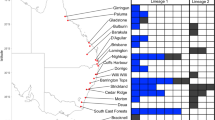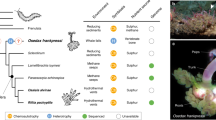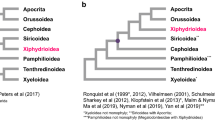Abstract
The processes and mechanisms underlying the diversification of host–microbe endosymbiotic associations are of evolutionary interest. Here we investigated the bacteriocyte-associated primary symbionts of weevils wherein the ancient symbiont Nardonella has experienced two independent replacement events: once by Curculioniphilus symbiont in the lineage of Curculio and allied weevils of the tribe Curculionini, and once by Sodalis-allied symbiont in the lineage of grain weevils of the genus Sitophilus. The Curculioniphilus symbiont was detected from 27 of 36 Curculionini species examined, the symbiont phylogeny was congruent with the host weevil phylogeny, and the symbiont gene sequences exhibited AT-biased nucleotide compositions and accelerated molecular evolution. These results suggest that the Curculioniphilus symbiont was acquired by an ancestor of the tribe Curculionini, replaced the original symbiont Nardonella, and has co-speciated with the host weevils over evolutionary time, but has been occasionally lost in several host lineages. By contrast, the Sodalis-allied symbiont of Sitophilus weevils exhibited no host–symbiont co-speciation, no AT-biased nucleotide compositions and only moderately accelerated molecular evolution. These results suggest that the Sodalis-allied symbiont was certainly acquired by an ancestor of the Sitophilus weevils and replaced the original Nardonella symbiont, but the symbiotic association must have experienced occasional re-associations such as new acquisitions, horizontal transfers, replacements and/or losses. We detected Sodalis-allied facultative symbionts in populations of the Curculionini weevils, which might represent potential evolutionary sources of the Sodalis-allied primary symbionts. Comparison of these newcomer bacteriocyte-associated symbiont lineages highlights potential evolutionary trajectories and consequences of novel symbionts after independent replacements of the same ancient symbiont.
Similar content being viewed by others
Log in or create a free account to read this content
Gain free access to this article, as well as selected content from this journal and more on nature.com
or
Accession codes
Accessions
DDBJ/GenBank/EMBL
References
Alonso-Zarazaga MA, Lyal CHC . (1999) A World Catalogue of Families and Genera of Curculionoidea (Insecta: Coleoptera). Entomopraxis: Barcelona, Spain.
Baldo L, Dunning Hotopp JC, Jolley KA, Bordenstein SR, Biber SA, Choudhury RR et al. (2006). Multilocus sequence typing system for the endosymbiont Wolbachia pipientis. Appl Env Microbiol 72: 7098–7110.
Baumann P . (2005). Biology of bacteriocyte-associated endosymbionts of plant sap-sucking insects. Annu Rev Microbiol 59: 155–189.
Bourtzis K, Miller TA . (2003) Insect Symbiosis. CRC Press: Boca Raton, FL, USA.
Buchner P . (1965) Endosymbiosis of Animals with Plant Microorganisms. Interscience: New York, NY, USA.
Castresana J . (2000). Selection of conserved blocks from multiple alignments for their use in phylogenetic analysis. Mol Biol Evol 17: 540–552.
Chrudimský T, Husník F, Nováková E, Hypša V . (2012). Candidatus Sodalis melophagi sp. nov.: phylogenetically independent comparative model to the tsetse fly symbiont Sodalis glossinidius. PLoS One 7: e40354.
Clayton AL, Oakeson KF, Gutin M, Pontes A, Dunn DM, von Niederhausern AC et al. (2012). A novel human-infection-derived bacterium provides insights into the evolutionary origins of mutualistic insect–bacterial symbioses. PLoS Genet 8: e1002990.
Conord C, Despres L, Vallier A, Balmand S, Miquel C, Zundel S et al. (2008). Long-term evolutionary stability of bacterial endosymbiosis in Curculionoidea: additional evidence of symbiont replacement in the Dryophthoridae family. Mol Biol Evol 25: 859–868.
Dale C, Maudlin I . (1999). Sodalis gen. nov. and Sodalis glossinidius sp. nov., a microaerophilic secondary endosymbiont of the tsetse fly Glossina morsitans morsitans. Int J Syst Evol Microbiol 49: 267–275.
Farrell BD . (1998). ‘Inordinate fondness’ explained: why are there so many beetles? Science 281: 555–559.
Fujimoto H . (2004). The list of Japanese Curculioninae. Newsletter Japanese Weevil Information Network 3: 2–6 [In Japanese].
Fukatsu T . (1999). Acetone preservation: a practical technique for molecular analysis. Mol Ecol 8: 1935–1945.
Fukatsu T, Aoki S, Kurosu U, Ishikawa H . (1994). Phylogeny of Cerataphidini aphids revealed by their symbiotic microorganisms and basic structure of their galls: implications for host-symbiont coevolution and evolution of sterile soldier castes. Zool Sci 11: 613–623.
Fukatsu T, Ishikawa H . (1992). A novel eukaryotic extracellular symbiont in an aphid, Astegopteryx styraci (Homoptera, Aphididae, Hormaphidinae). J Insect Physiol 38: 765–773.
Fukatsu T, Ishikawa H . (1996). Phylogenetic position of yeast-like symbiont of Hamiltonaphis styraci (Homoptera, Aphididae) based on 18S rDNA sequence. Insect Biochem Mol Biol 26: 383–388.
Fukatsu T, Koga R, Smith WA, Tanaka K, Nikoh N, Sasaki-Fukatsu K et al. (2007). Bacterial endosymbiont of the slender pigeon louse, Columbicola columbae, allied to endosymbionts of grain weevils and tsetse flies. Appl Env Microbiol 73: 6660–6668.
Fukatsu T, Nikoh N . (1998). Two intracellular symbiotic bacteria from the mulberry psyllid Anomoneura mori (Insecta, Homoptera). Appl Env Microbiol 64: 3599–3606.
Grenier AM, Nardon C, Nardon P . (1994). The role of symbiotes in flight activity of Sitophilus weevils. Entomol Exp Appl 70: 201–208.
Grenier AM, Nardon P, Bonnot G . (1986). Importance de la symbiose dans la croissance des populations de Sitophilus oryzae L. (Coleoptère Curculionidae). Etude théorique et expérimentale. Acta oecologica—Oecologia Applicata 7: 93–110.
Grünwald S, Pilhofer M, Höll W . (2010). Microbial associations in gut systems of wood- and bark-inhabiting longhorned beetles [Coleoptera: Cerambycidae]. Syst Appl Microbiol 33: 25–34.
Hayashi K, Morimoto K, Kimoto S . (1984) The Coleoptera of Japan in Color Vol. IV. Hoikusha Publishing Co., Ltd: Osaka, Japan, [In Japanese].
Heddi A, Grenier AM, Khatchadourian C, Charles H, Nardon P . (1999). Four intracellular genomes direct weevil biology: nuclear, mitochondrial, principal endosymbiont, and Wolbachia. Proc Natl Acad Sci USA 96: 6814–6819.
Heddi A, Nardon P . (2005). Sitophilus oryzae L.: a model for intracellular symbiosis in the Dryophthoridae weevils (Coleoptera). Symbiosis 39: 1–11.
Hongoh Y, Ishikawa H . (2000). Evolutionary studies on uricases of fungal endosymbionts of aphids and planthoppers. J Mol Evol 51: 265–277.
Hosokawa T, Fukatsu T . (2010). Nardonella endosymbiont in the West Indian sweet potato weevil Euscepes postfasciatus (Coleoptera: Curculionidae). Appl Entomol Zool 45: 115–120.
Hughes J, Vogler AP . (2004a). Ecomorphological adaptation of acorn weevils to their oviposition site. Evolution 58: 1971–1983.
Hughes J, Vogler AP . (2004b). The phylogeny of acorn weevils (genus Curculio) from mitochondrial and nuclear DNA sequences: the problem of incomplete data. Mol Phylogenet Evol 32: 601–615.
Jobb G, Von Haeseler A, Strimmer K . (2004). TREEFINDER: a powerful graphical analysis environment for molecular phylogenetics. BMC Evol Biol 4: 18.
Kaiwa N, Hosokawa T, Kikuchi Y, Nikoh N, Meng XY, Kimura N et al. (2010). Primary gut symbiont and secondary, Sodalis-allied symbiont of the scutellerid stinkbug Cantao ocellatus. Appl Env Microbiol 76: 3486–3494.
Kaiwa N, Hosokawa T, Kikuchi Y, Nikoh N, Meng XY, Kimura N et al. (2011). Bacterial symbionts of the giant jewel stinkbug Eucoryssus grandis (Hemiptera: Scutelleridae). Zool Sci 28: 169–174.
Katoh K, Toh H . (2008). Recent developments in the MAFFT multiple sequence alignment program. Brief Bioinformatics 9: 286–298.
Kikuchi Y, Hosokawa T, Fukatsu T . (2007). Insect-microbe mutualism without vertical transmission: a stinkbug acquires a beneficial symbiont from the environment every generation. Appl Env Microbiol 73: 4308–4316.
Kikuchi Y, Hosokawa T, Fukatsu T . (2011). An ancient but promiscuous host-symbiont association between Burkholderia gut symbionts and their heteropteran hosts. ISME J 5: 446–460.
King RC, Sang JH . (1959). Oögenesis in adult Drosophila melanogaster. VIII. The role of folic acid in oögenesis. Growth 23: 37–53.
Kuriwada T, Hosokawa T, Kumano N, Shiromoto K, Haraguchi D, Fukatsu T . (2010). Biological role of Nardonella endosymbiont in its weevil host. PLoS ONE 5: 165–190.
Lefèvre C, Charles H, Vallier A, Delobel B, Farrell B, Heddi A . (2004). Endosymbiont phylogenesis in the Dryophthoridae weevils: evidence for bacterial replacement. Mol Biol Evol 21: 965–973.
Legendre P, Desdevises Y, Bazin E . (2002). A statistical test for host-parasite coevolution. Syst Biol 51: 217–234.
Matsuura Y, Kikuchi Y, Meng XY, Koga R, Fukatsu T . (2012). Novel clade of alphaproteobacterial endosymbionts associated with stinkbugs and other arthropods. Appl Env Microbiol 78: 4149–4156.
McKenna DD, Sequeira AS, Marvaldi AE, Farrell BD . (2009). Temporal lags and overlap in the diversification of weevils and flowering plants. Proc Natl Acad Sci USA 106: 7083–7088.
Meier-Kolthoff JP, Auch AF, Huson DH, Göker M . (2007). CopyCat: cophylogenetic analysis tool. Bioinformatics 23: 898–900.
Moran NA, McCutcheon JP, Nakabachi A . (2008). Genomics and evolution of heritable bacterial symbionts. Annu Rev Genet 42: 165–190.
Morimoto K . (1960). Revision of the subfamily Curculioninae from Japan I (Coleoptera). Mushi 33: 89–104.
Morimoto K . (1962). Revision of the subfamily Curculioninae from Japan II (Coleoptera). Mushi 36: 21–40.
Nardon P . (1973). Obtention d'une souche aposymbiotique chez le charancon Sitophilus sasakii Tak: differentes methods et comparaison avec la souche symbiotique d'origine. CR Acad Sci 277: 981–984.
Nardon P, Nardon C . (1998). Morphology and cytology of symbiosis in insects. Ann Soc Entomol Fr 34: 105–134.
Nováková E, Hypša V . (2007). A new Sodalis lineage from bloodsucking fly Craterina melbae (Diptera, Hippoboscoidea) originated independently of the tsetse flies symbiont Sodalis glossinidius. FEMS Microbiol Let 269: 131–135.
Oliver KM, Degnan PH, Burke GR, Moran NA . (2010). Facultative symbionts in aphids and the horizontal transfer of ecologically important traits. Annu Rev Entomol 55: 247–266.
Plarre R . (2010). An attempt to reconstruct the natural and cultural history of the granary weevil, Sitophilus granarius (Coleoptera: Curculionidae). Eur J Entomol 107: 1–11.
Robinson-Rechavi M, Huchon D . (2000). RRTree: relative-rate tests between groups of sequences on a phylogenetic tree. Bioinformatics 16: 296–297.
Ronquist F, Huelsenbeck JP . (2003). MrBayes 3: Bayesian phylogenetic inference under mixed models. Bioinformatics 19: 1572–1574.
Russell JA, Latorre A, Sabater-Muñoz B, Moya A, Moran NA . (2003). Side-stepping secondary symbionts: widespread horizontal transfer across and beyond the Aphidoidea. Mol Ecol 12: 1061–1075.
Shimodaira H . (2002). An approximately unbiased test of phylogenetic tree selection. Syst Biol 51: 492–508.
Shimodaira H, Hasegawa M . (2001). CONSEL: for assessing the confidence of phylogenetic tree selection. Bioinformatics 17: 1246–1247.
Stork NE . (2003). Biodiversity. In: Resh VH, Carde RT, (eds) Encyclopedia of Insects. Academic Press: San Diego, CA, USA, pp 85–91.
Sugiura S, Yamazaki K, Hishi T . (2002). A cecidophagous weevil, Curculio albovittatus (Coleoptera: Curculionidae), in the gall of Pontania sp. (Hymenoptera: Tenthredinidae). Entomol Sci 5: 193–196.
Tanabe AS . (2008), ‘Phylogears version 1.5’, software distributed by the author at http://www.fifthdimension.jp/.
Tanabe AS . (2011). Kakusan4 and Aminosan: two programs for comparing nonpartitioned, proportional, and separate models for combined molecular phylogenetic analyses of multilocus sequence data. Mol Ecol Notes 11: 914–921.
Toju H, Fukatsu T . (2011). Diversity and infection prevalence of endosymbionts in natural populations of the chestnut weevil: relevance of local climate and host plants. Mol Ecol 20: 853–868.
Toju H, Hosokawa T, Koga R, Nikoh N, Meng XY, Kimura N et al. (2010). ‘Candidatus Curculioniphilus buchneri,’ a novel clade of bacterial endocellular symbionts from weevils of the genus Curculio. Appl Env Microbiol 76: 275–282.
Weinert LA, Werren JH, Aebi A, Stone GN, Jiggins FM . (2009). Evolution and diversity of Rickettsia bacteria. BMC Biol 7: 6.
Wernegreen JJ . (2002). Genome evolution in bacterial endosymbionts of insects. Nat Rev Genet 3: 850–861.
Werren JH, Baldo L, Clark ME . (2008). Wolbachia: master manipulators of invertebrate biology. Nat Rev Microbiol 6: 741–751.
Acknowledgements
We thank, H Fujimoto, H Hirano, K Kume, H Makihara, K Matsushita and H Yoshitake for their help in collecting insect specimens and H Kojima and K Morimoto for providing ecological information of Curculionini weevils. This work was funded by the Japan Society for the Promotion of Science (No. 2004352) to HT and by the Program for Promotion of Basic and Applied Researches for Innovations in Bio-oriented Industry (BRAIN) to TF.
Author information
Authors and Affiliations
Corresponding author
Additional information
Supplementary Information accompanies the paper on The ISME Journal website
Rights and permissions
About this article
Cite this article
Toju, H., Tanabe, A., Notsu, Y. et al. Diversification of endosymbiosis: replacements, co-speciation and promiscuity of bacteriocyte symbionts in weevils. ISME J 7, 1378–1390 (2013). https://doi.org/10.1038/ismej.2013.27
Received:
Revised:
Accepted:
Published:
Issue date:
DOI: https://doi.org/10.1038/ismej.2013.27
Keywords
This article is cited by
-
Nutrient supplementation by genome-eroded Burkholderia symbionts of scale insects
The ISME Journal (2023)
-
Symbioses shape feeding niches and diversification across insects
Nature Ecology & Evolution (2023)
-
Uncovering Active Bacterial Symbionts in Three Species of Pollen-feeding Beetles (Nitidulidae: Meligethinae)
Microbial Ecology (2023)
-
Localization of symbiotic bacteria in embryogenesis of the lesser grain borer Rhyzopertha dominica and the African powderpost beetle Lyctus africanus (Coleoptera: Bostrichidae)
Applied Entomology and Zoology (2023)
-
The genus Sodalis as a resource for understanding the multifaceted evolution of bacterial symbiosis in insects
Symbiosis (2023)



